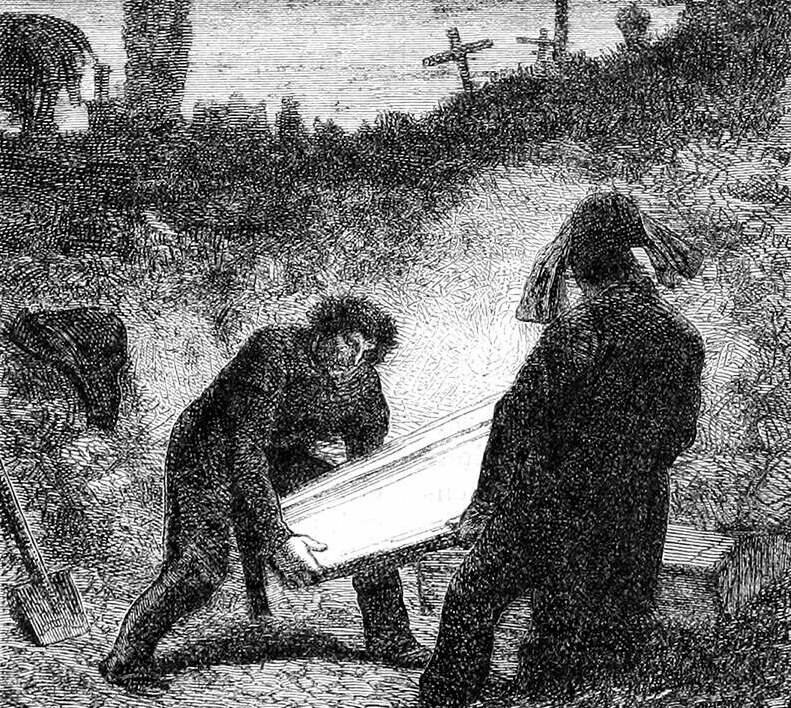
IN 1634, GOODMAN BRADSTREET and William White were the first Englishmen to homestead in the southwestern part of Ipswich, a town of the Massachusetts Bay Colony. The Native American name for the area was “Chebacco,” after a nearby lake, and for the next 50 years, it was an out-of-the-way spot, sparsely settled, on the route to the village of Gloucester.
During this time, residents of all ages in the Chebacco area were required to walk in any weather the six-plus mile footpath to Ipswich Center for all-day Sunday services—no doubt a difficult journey. In addition, any members of the Chebacco community who passed away during this time were expected to be buried in the central Ipswich burial ground on the high street. The Chebacco deceased had to be carried on “a bier upon the shoulders of men” for the six miles mentioned above, a task even more arduous and distasteful.
To cut down their commute, the residents on the Chebacco side of town—now known as Essex—began the process of exploring self-determination. The two towns still can’t seem to agree on the exact timeline, but starting in 1673, Chebacco residents began to petition for their own meetinghouse and burial ground on their side of town. By 1680, Chebacco residents hired the Reverend John Wise to be their own preacher, set aside an acre-lot for their very own burial yard, and officially became known as Ipswich’s Second Parish.
One-hundred thirty-eight years later, that local yard would become infamous for a set of events straight out of a Gothic horror novel—the largest recorded multiple grave-robbing in 19th Century New England.
The aspiring doctor comes to town
Thomas Sewall, son of Thomas and Priscilla Coney Sewall, was born on April 16, 1786, in a small village on the Kennebec River in Maine. A bright and diligent student, 21-year-old Sewall moved to Massachusetts in 1807, attending lectures at Harvard Medical School and studying under the renowned Boston doctor Dr. John Jeffries. Sewall excelled in his studies, even winning a prize in 1810 for his dissertation on “Diseases of the Breasts of Nursing Women.” In 1812, Sewall graduated from Harvard Medical School. Later that fall, he became a member of the Massachusetts Medical Society.
Upon moving to Massachusetts, Sewall boarded at the home of Miriam Foster Choate on what is now Spring Street in Essex. Miriam was a recent widow who had married into the large and prosperous Choate family. The Choates were one of the “first families” of Chebacco, settling the area in the 1600s, and a clan that included judges, ship captains, and Revolutionary War heroes.
The family owned multiple properties in town, including an island on Essex Bay. Miriam’s husband had recently purchased the Spring Street home before he passed.
No doubt Mrs. Choate welcomed the addition of the handsome, dark-haired medical student not just for whatever payment he made and chores around the house he performed but also for his acting as a tutor for two of her six children—David Jr. and Rufus. Sewall instructed the precocious Boys Latin School and other subjects and maintained a lifelong friendship with his two students.
This isn’t perhaps too surprising, for they were also brothers-in-law. When Sewall moved into the Choate house in 1809, Miriam’s oldest daughter, Mary, was seventeen. Thomas Sewall and Mary Choate caught each other’s eye, and the match must have met the approval of the maternal landlord, and they married in 1813. They didn’t move far—the “Choate House” was, in fact, a handsome clapboard double-house, so there was plenty of room.
The young doctor and his bride settled down to a life of domestic bliss, community engagement and professional success. In 1818, Dr. Sewall became the Second Parish treasurer. Dr. Sewall's medical practice was thriving, proficient in his ministrations and well-respected as the community doctor.
A bit of context
By the first decade of the 19th Century, the Chebacco’s 1,207 residents had successfully managed a level of self-determination as Ipswich’s Second Parish for over a century. They had their own meetinghouse and pastor—the latest being the Reverend Robert Crowell, hired in 1814. They had their own burial ground.
Although the trek to the town center was less frequent, they were still technically, legally, and financially part of Ipswich and not happy about it. That is why they were considering a petition to the Massachusetts Legislature to break off and form their own town. Dr. Sewall, in fact, was a member of the committee in charge of the petition process.
Meanwhile, the medical profession in the young United States of America—particularly in New England—is booming. Medical schools are springing up in the cities, with thousands of students eager to attend. Recent medical school graduates like our Dr. Sewall are setting up family practices in towns and villages.
Some—again, like our Dr. Sewall—are acting as “preceptors,” which means they are willing to provide clinical training to aspiring medical students before heading to med school. And some, of course— like our Dr. Sewall— are anatomists, i.e., proficient in the training and practice of anatomy. In fact, Dr. Sewall has a side gig as an anatomy lecturer to local students.
Now, if you’re going to teach anatomy, there is only so much you can explain using a dog-eared, shared textbook. You’ll need some “hands-on” practice dissecting a human body or, preferably, bodies. (More bodies = more practice)
So, more bodies. Who’s going to find them for you?
Next week: body snatching, “Spunkers,” Adam Smith, religion, and the folks of Essex discover there is another side of the good Dr. Sewall.
Robert “Rob” Fitzgibbon is an Essex resident, a Library Trustee, and a former member of the Essex Finance Committee. He writes about colorful local history on his Medium blog, “Chebacco Parish.” On October 28, Fitzgibbon will speak with Gloucester historian Wayne Soini about a 1930s era double murder in Rockport that remains unsolved: "Main Street Murder," 9 a.m. Saturday, Oct 28 at Gloucester High School, Lecture Hall, 2nd floor. Info at https://www.finnfunn.org/ghs.html#murder.